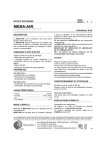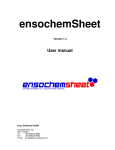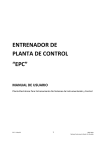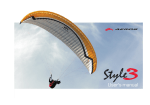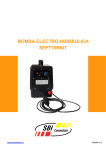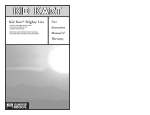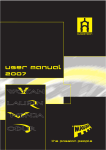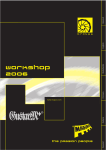Download Tube Expansion Torque Control
Transcript
TORQUE CONTROL UNIT OPERATION AND SERVICE MANUAL YOUR TUBE EXPANSION SET COMPRISES OF THIS ALWAYS 1) Tube Expansion Torque Control Unit with power cord. 2) Tube Expanding Drive Unit/s; one or more of the Drivers Models TM-0, TM-1, TM-2 or TM-3; with multi-core cable and plug. OPTIONAL 3) ‘FREELOAD’ Balancer to suspend the Drive Units; capacity depending on the drive model. 4) A set of Foot Switches (3) to relieve the operator from using fingers to trigger the unit on and off. 5) Telescopic Shaft to enable tube expansion, free of the drive reaction torque. 6) Tube expansion Simplifier to utilize the above Drivers for the expansion of larger diameter tube: available in ratios of 5 and 25. 7) Tube Expansion Trolley to store all the above equipment and tube work related tools; it can also be used as a tube expansion workstation. QUICK REFERENCE DRIVE MODELS FULL LOAD SPEED R.P.M. EXPANSION RANGE STEEL TUBES OD MM COPPER TUBES O D IN MM 350 380 6 TO 12 10 TO 16 8 TO 16 13 TO 22 TM-2L TM-3L TM-3LM5 350 170 45 16 TO 28 25 TO 45 25 TO 57 19 TO 34 36 TO 65 38 TO 100 TM-2LM25 TM-3LM25 14 7 38 TO 63 50 TO 102 230 N NO 110 V NO TM-ON TM-IN TM-OL TM-1L TN-2N TM-3N TM-2NM5 TM-2NM25 TM-3NM25 DRIVE WEIGHT KGS FULL LOAD CURRENT (AMPS) FULL LOAD TORQUE (Kg. Mtr.) 230 V 110 V 2.8 3.7 1.5 3.0 3.0 6.0 042 0.68 7.8 11.3 16.0 4.0 6.0 6.0 8.0 12.0 12.0 1.60 2.70 12.00 15.0 19.0 4.0 6.0 8.0 12.0 31.50 53.00 BASIC SETUP AND USE Connect the Control Unit power cord to the appropriate supply viz. 220 VAC/110 VAC. Connect the Drive Unit to the socket provided at the real of the Control Unit by Plugging in and turning anti-clockwise with a slight pressure. Turn the Drive Selector Switch on the Control Unit to point to the Drive model connected. Select Single Cycle or Auto Repeat with the toggle switch as you prefer. Single Cycle operation is the manual way, triggering on and off with each new tube being expanded. In Auto Repeat, triggering the Drive on and off is eliminated and the timing is set with the Reserve and Pause Controls. The timing can be determined and set on the job. Power-On the Control Unit and press the Manual Reserve Pushbutton for a moment to check that the connection is correct. Turn the Set Knob clock-wise gently till it stops rotating. If Foot Switches are to be used for operation, connect the Foot Switches to the Control Unit through the socket provided on the side. Toggle the selector, near the socket, to select foot operation. The green, red and yellow switches are meant for Start, Stop and Reserve, Pressing the ‘Start’ stops the Drive. ‘Reserve’ is used if the drive did not reserve completely. Trigger on the Drive Unit and leave it on rotate in the “Forward” direction (clockwise as viewed from the rear) Turn the Set Knob anticlockwise gradually and keep turning till the Drive “Trip” is achieved. After a delay, the drive will start rotating in the “Reserve” direction. If Auto Repeat is selected, the Drive will “Pause” after timing out in “Reserve” and restart for the new cycle. The “Reserve” time is the time for which the Drive will “Reserve” after “Trip” The “Pause” time setting is the time interval between two consecutive cycles or tubes being expanded. The setting point at which the Drive “Tripped” is the “No Load” setting and can be read by pressing the “Press” pushbutton. This setting is the starting point from which further setting for Tube Expander is to be done. The setting required for Tube Expansion can be determined on a Mock-up Sheet or on job. Start at a lower setting and increase as required. Repetition will lead to the proper setting after determining the extent of tube wall thinning required. The Unit is now completely set up and ready for use. COMPLETE SYSTEM SETUP CASE 1:The Balancer supplied is to be used to suspend the Drive Unit. The operator can thus be relived from the weight of the Drive Unit. A set of stands can be used with a rod between two to support the Balancer. This arrangement can be used for the tube expansion controlling the Drive Unit with the trigger switch of the Drive Unit or Foot Switches. CASE 2:Tube Expansion Trolley supplied can accommodate one complete set of tube expansion equipment comprising the Control Unit, Drive Units, Tube Expansion Simplifier, Telescopic Shaft, Foot Switches, Balancer and the Tools needed for tube expansion. The overhead Arm fitted on the trolley is used for the suspension of the Balancer and the Drive Unit, when the Drive Unit is hand –head in use. It supports the Telescopic Shaft when the Drive Unit is suspended on the Trolley Bar. In either case the operation can be done by Foot Switches. CASE 3:The Tube Expansion Simplifier is a co-axial gear unit. It is used in cases where Drive unit along dose not deliver the required torque for tube expansion. The Simplifier is coupled directly to the Drive Unit. The Simplifier has a Bracket which holds a tube assembly. This assembly is inserted in an adjacent tube and helps in overcoming the high reaction torque which develops during expansion. The Tube Expansion is to be coupled to the simplifier and fitted onto it in the square drive female. This arrangement can be suspended on the Balancer to relieve the operator from the weight of the Drive and Simplifier. TROUBLE SHOOTING 1. a) The Power lamp dose not glow after switch ON. Also DPM display does not light up. - Check transformer, if found OK - Check + 5V regulated power supply on PCB. b) If DPM light up but power ON lamp dose not light up. - Power ON LED is defective. 2. Forward indicator lamp glows, but forward contractor doses not go ON. - Check the contactor coil and if ok Replace main PCB. 3. Reserve indicator lamp glows, but reserve contractor doses not go ON. - Check the contractor coin and if ok Replace main PCB. 4. Forward & reserve contractor go ON, but the drive does not start. - Check if LED L4 (Green) on PCB light up, when either of the contractor goes ON. a) L4 does not light up – replace PCB. b) L4 light up – replace electronic switch. 5. The reserve contractor does not go ON for manual reserve operation but works in Auto repeat position. - Check Relay 1 6. The panel does not show forward, Trip or reserve lamps in trigger position. a) Check transformer, if OK, b) Check + 12V regulated power supply on PCB. - Replace PCB if + 12V power supply is not OK. 7. None of the Trip, forward and reverse lamps light up in foot switch operation, but light up in - Check Relay 2 8. The Power ON lamp lights up, but current read out is blank. - Check 4 pin connector of DPM and replace DPM is necessary. 9. For any discrepancy in either of the timings. 10. The fuse blows the moment forward or reserve contractor goes ON the capacitor across that contactor coil is short circuited. Replace it. WIRING AND MAINTENANCE OF DRIVE UNIT WIRING DIAGRAM The pin numbers shown above are the pin number of the 12 pin Plug attached to the Drive Cable The pin numbers are shown on the inside of the plug, next to each pin. It is essential that when wiring, enough solder flows through the pins. MAINTENANCE HINTS Prolonged use of a Drive Unit subjects certain parts to wear and tear. If these parts are maintained properly or replaced when needed, the life of the Drive Unit can severely reduce. FOR PREVENTIVE MANTENANCE: 1) Disconnect the power supply. 2) Remove the covers (wherever necessary). 3) Remove Brush Caps and Carbon Brushes. 4) Clean the Commutator periodically with a jet of air. 5) Replace the Carbon Brushes after operation for 1000 hour or when they are worm out. TO CLEAN THE COMMUTATOR: Blow away the dust and dirt with a jet or air through the inspection opening. If the surface appears caked, clean it with 00 sandpaper before blowing. In case of fitting, hold 00 sandpaper against the surface with your hands and rotate the spindle manually clean surface with a brush and a jet of air. REPLACEMENT OF CARBON BRUSHES: It is advisable to replace Carbon Brushes in pairs. This ensures that spring tension is equal on both the brushes, resulting the Brush Caps; ensure that the Carbon Brushes are sliding fit in the Brush Holders. Use only genuine ‘TRISTAR’ Carbon Brushes since inferior quality wrong grade of Brushes can result communication, thereby damaging the machine. CIRCUIT FUNCTION DESCRIPTION With the power ON, IC6 generates a reset pulse which is applied to the timers. IC 1,3,4, & 5 AND these are initialized. IC1 then starts its delay cycle and activates transistor T1 after a set delay. This delay period depends upon the type of expanding machine used and different timing are selected for the drive type, selected by the external switch on the front panel. LED L1 on the PCB light up to show that is this initial delay has elapsed. At the power ON, forward Triac pair energized via the pulse transformer PT1. When the current signal from the CT exceeds the set limit (set by the controls on the front panel and read off on the comparator circuit IC2 activates transistor T-2. Transistor T-1 and T-2 from an and gate charges the LATCH circuit output, and cut off supply to forward Triacs. At the same time the half period. This half period is controlled by present P7 on the PCB IC-3 in turn triggers the reserve timer IC-4, IC-4 in turn triggers IC-5, which controls the intercycle half period. For single cycle operation, IC-5 is disabled by ‘Single Cycle’ switch ON the front panel and the reverse timer goes on indefinitely. LED L-1, L-2, L-3 on the PCB indicate the operation of timer IC-1, IC-4. The Triacs are driven by identical circuits. Transistor T7, T9 with pulse transformer PT1 drive the forward TRIACs. Transistor T8, T10 with pulse transformer PT2 drive the reverse TRIACs. Transistor T3 drivers ‘FORWARD’ LED, Transistor T4 drivers REVERSE LED and Transistor T5 drivers TRIP LED. The DC Power supplies + 5V using IC-7805 and +12V using IC-7812 are located on the PCB itself. The DPM is supplied with + 5V supply & the circuit with + 12V. Enclosed in this operating manual are wiring diagram for the complete panel, solid state power circuit and control circuit for relays. Also enclosed are location diagram for the printed circuit board and the other circuit components on the chasis. This diagram along with circuit expansion as above should enable any competent technician to locate faults and repaid the same as many be necessary. DIGITAL TORQUE CONTROLLER (SOLID STATE) TROUBLE SHOOTING 1. a) The power lamp does not glow after switch ON. Also DPM display does not light up. * Check the transformer; if found OK. * Check +5V trequlated power supply on PCB. b) If DPM light up but power ON lamp does not light up. * Power ON LED IS defective. 2 Forward indicator lamp glows, but the drive does not run reverse. * Check if drive runs in manual reserve mode; if not, replace the main card and if that does not work; then replace drive card. 4. MCB trips the moment the drive runs in either forward or reverse direction; one of the triac is defective (short circuit). * Replace the drive card (triac assembly). 5. Reserve does not work in manual reserve operation but works in auto repeat position. * Check Relay – 1(R1). 6. The panel does not show forward lamp when in trigger mode & drive does not run, but DPM lights up with power ON LED. * Check the contacts between cutter hammer plug & socket; if the fault persists then; * Check the Relay-2 (R2). 7. The panel does not show forward, reverse, & trip lamps in trigger position & manual reverse does not operate; * Check the transformer ; if ok * Check the + 12V regulated power supply on the main card. If not ok, then replace the PCB board. 8. None of the trip, forward & reverse lamps light up in foot switch & trigger switch operation, but manual reverse does operate; * Check relay – 2 (foot switch + trigger ) (R2) 9. For any discrepancy in either of the timings (Reverse & Pause) & the initial bypass time. * Check respective potentiometers & if required replace the main card. 10. The fuse blows the moment forward or reverse motion of the drive is on. * The drive card (triac assembly) is faulty. Replace it.( In this case if the MCB does not trip along with the fuse, the MCB is likely to be defective. Assuming that the fuse has the same rating as that of the MCB). 11. The various components on the chasis can be checked by multimeter. a) Transformer : 230 / 11V or 110V / 11V / 18V / 18V b) CT : Check continuity in primary & secondary c) Relays : 12VDC, 2CHO TESTING OF DRIVE CARD A) DRIVE CARD FOR 230V 10A & 110V 20A PWM PANEL 1. For any operation ( forward or reverse ), if any of the triac in the pair is short circuited the MCB will trip the moment forwad or reverse respective drive motion is loaded. (i.e. if a forward triac is short the reverse motion will trip the panel & if one of the reverse triac is short, then the MCB will trip as soon as the trigger switch is pressed). 2. If one of the triac in any pair (forward or reverse) is open, that particular operation will not take place (i.e. if forward triac is open then forward operation will not take place & vice- versa.) NOTE : Replace the triac with same ratings for good results ( BT-139 \ 15 Amp \ 800 Volts). IMPORTANT NOTE : Replace the triac with same ratings for good results (BT- 139 \ 15Amp \ 800 Volts). IMPORTANT NOTE : In no case disturb presents (p1 to p7) Present P5 & P6 are factory calibrated and hence must not be disturbed at all. SOLID STATE AUTOMATIC AC VOLTAGE STABILIZER Line voltage variations is a common phenomenon everywhere. Sensitive electronic equipments can perform satisfactorily, if the voltage is maintained within certain limits. While under voltages lead to malfunctions, over voltages lead to burn outs of components in the electronic instruments. The digital torque controller assumes that, the supply voltage is constant and hence the torque bears linear relationship with the current. Thus, for uniform expansion of tubes, the supply voltage needs to be constant. Automatic AC Voltage Stabilizer has been designed with fully solid state circuitry. The various models are specially designed keeping in mind the requirements of Digital Torque Controllers. The output is maintained within _+ 5 % of the nominal output voltage of either 230VAC or 110VAC. Solid state circuit requires no repetitive maintenance. [10] FEATURES 1. Fully solid state circuitry. 2. Use of triacs makes the automatic tap changing operation sparkles. No wear & tear and hence no repetitive maintenance, 3. Reliable circuitry gives long trouble free life. 4. Plug in type design makes servicing easy & quick 5. LED indication of input line voltage. 6. Digital display for indication of output voltage. 7. MCB protects the unit and connected load against high currents/short circuits. 8. Individual wire fuses provided for triacs. TROUBLE SHOOTING All the components used are suitable derated. The design makes use of latest techniques in AC power contro. Hence, in normal course the unit will give long trouble free life. However, in case of trouble, the following instruction will help repair the unit quickly. 1.The stabilizer unit consists of a main transformer (auto transformer in case of 230V output & double wound with isolated secondary transformer in case of 110V output) & two control transformers. Normally, the transformers will not fail. However, they can be checked with multimeter for continuity at primary & secondary windings. 2. The unit has one PCB, which houses all the control circuits and triac. In the event of a triac becoming defective (short circuited) the wire fuse pertaining to that triac will fail. In this output LED indication will be available, but there will be no output. Thus at any time, if the output is not available, but input LED indicator is ON , check for an open fuse, replace it and also replace the short circuited triac in series with that fuse. In case a triac becomes defective (open circuited), the input LED indicators will be ON, the fuses will be intact, but the output will not be available. Replace that triac. 3.If the triac fuses keep failing, even with all triacs intact, then the fault is with the control circuit. Replace the PCB. 4. The LEDs for input voltage indication can be checked by multimeter. 5. If the DPM malfunctions, it can be replaced separately. SPECIFICATION The Solid State AC Voltage Stabilizers have the following specifications. Model : TVS-1 Input voltage range : 160 to 260V AC, 50Hz Output voltage : 110 +- 5%, 50Hz Capacity : 1 KVA, 1.5 KVA Dimensions : W * H *D (in mm) 264 165 314 Weight : 15 Kg (1KVA), 18Kg (1.5 KVA) Model : TVS-2 Input voltage range : 160 to 260V AC, 50Hz Output voltage : 230 +- 5%, 50Hz Capacity : 1 KVA, 1.5 KVA Dimensions : W * H *D (in mm) 264 165 314 Weight : 11 Kg (1KVA), 14Kg (1.5 KVA)
















